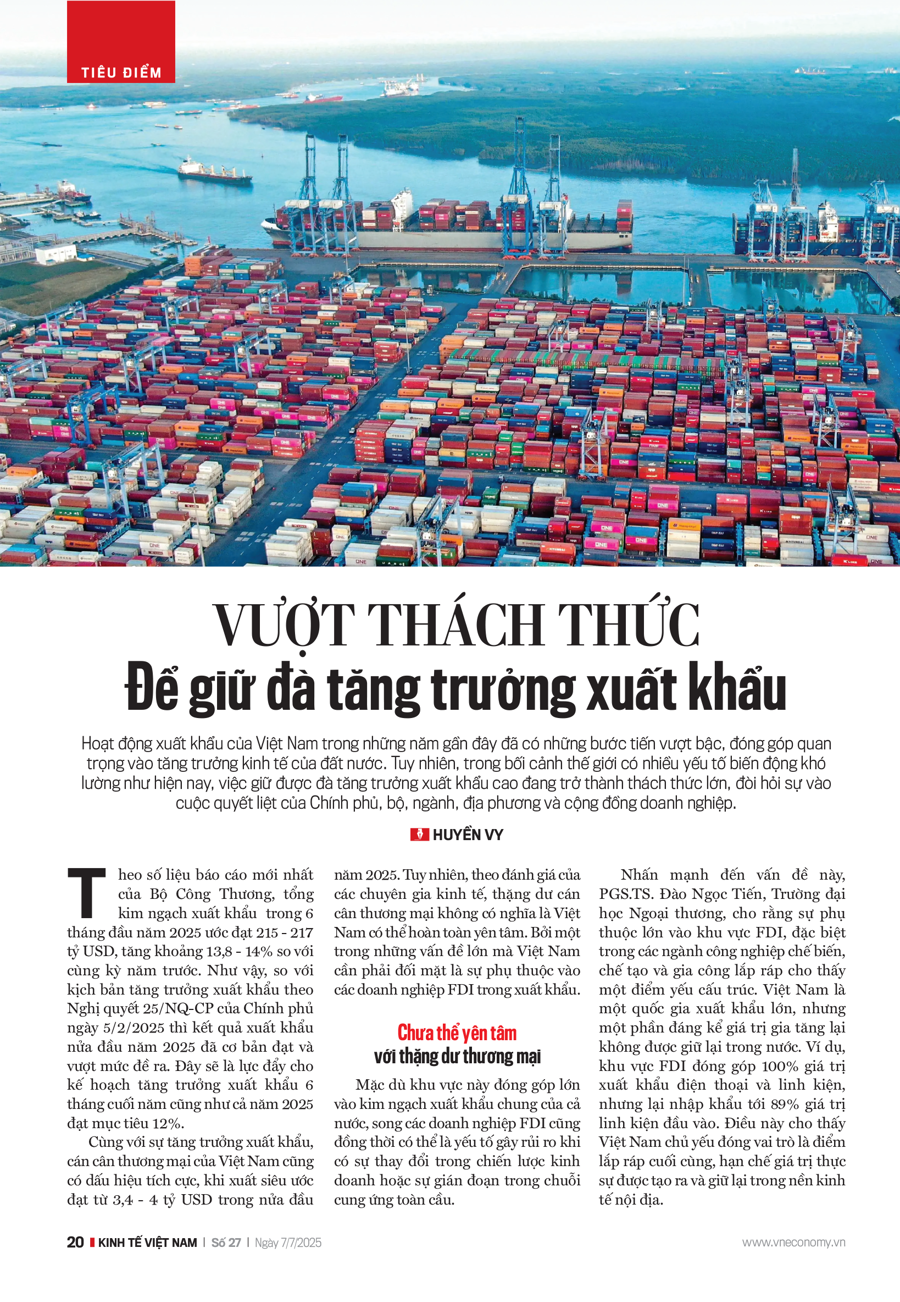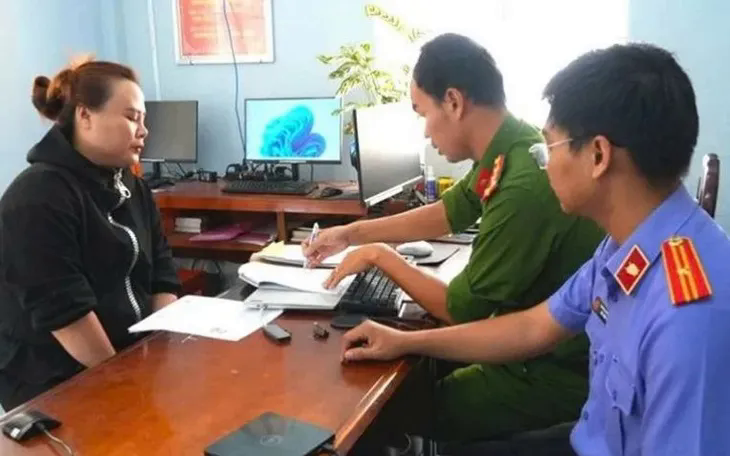According to the latest report by the Ministry of Industry and Trade, the total export turnover in the first six months of 2025 is estimated to reach 215-217 billion USD, an increase of about 13.8-14% compared to the same period last year. Thus, compared to the export growth scenario according to Resolution 25/NQ-CP of the Government on February 5, 2025, the export results in the first half of 2025 have basically achieved and exceeded the set targets. This will be a driving force for the export growth plan in the second half of the year as well as for the whole year of 2025 to achieve the target of 12%.
Along with the export growth, Vietnam’s trade balance also shows positive signs, with a surplus estimated at 3.4-4 billion USD in the first half of 2025. However, according to economic experts, a trade surplus does not mean that Vietnam can rest assured. One of the major problems that Vietnam needs to face is the dependence on FDI enterprises in exports.
NOT YET RELAX WITH TRADE SURPLUS
Although this sector contributes significantly to the country’s total export turnover, FDI enterprises can also be a risk factor when there are changes in business strategies or disruptions in the global supply chain.
Emphasizing this issue, Dr. Dao Ngoc Tien of the Foreign Trade University, said that the heavy dependence on the FDI sector, especially in the processing, manufacturing, and assembly industries, reveals a structural weakness. Vietnam is a major exporter, but a significant portion of the added value is not retained in the country. For example, the FDI sector contributes 100% of the export value of phones and components, but imports up to 89% of the value of input components. This shows that Vietnam mainly plays the role of the final assembly point, limiting the actual value created and retained in the domestic economy.

“The global economic context is undergoing profound changes, with economic, geopolitical, and technological issues rapidly shaping investment and trade flows. These changes not only create risks but also open up promising new growth drivers for Vietnam’s exports, especially in the fields of exploiting the efficiency of free trade agreements, promoting sustainable trade, and developing digital commerce.”
Vietnam has achieved remarkable successes in export activities, becoming one of the world’s leading export-oriented economies. However, to maintain rapid growth and ensure sustainability in the context of a volatile global economy, Vietnam needs to proactively respond to major trends such as digital transformation, green economy, supply chain restructuring, and requirements from new-generation FTAs. By synchronously and vigorously implementing these solutions, Vietnam can not only maintain impressive export growth but also improve the quality and sustainability of exports, contributing to the realization of high economic growth targets.”
According to Dr. Dao Ngoc Tien, despite the presence of large technology corporations such as Samsung, Intel, LG, and Foxconn, the contribution of the FDI sector to scientific and technological progress in the country is still modest. The linkage between FDI enterprises and domestic enterprises is described as “loose and lacking in depth”. Domestic enterprises face difficulties in deeply participating in the global value chain led by FDI enterprises.
Analyzing this issue further, at the workshop on “Building a Self-reliant and Self-sufficient Economy”, Dr. Le Xuan Nghia, an economic expert and former Vice Chairman of the National Financial Supervisory Commission, said that Vietnam exports more than 400 billion USD (in 2024), but 300 billion USD is from FDI enterprises, while Vietnamese enterprises only contribute 100 billion USD; of which, 50 billion USD comes from agriculture, where the domestic added value is up to 90%. The remaining 50 billion USD comes from the industrial sector, which sounds impressive, but when “peeled off”, the actual “Vietnamese-made” content accounts for only 35%. In other words, if converted substantively, only about 17 billion USD from industrial exports have Vietnamese content.
“Looking back at the journey of industrial development, Vietnam is proud to have attracted a series of FDI corporations, but if we analyze carefully, Vietnam mainly does low-cost assembly work, with very low added value, and the real profits lie with foreign corporations. Dependence on FDI not only makes us lag in technology but also causes us to miss out on the opportunity to have a sustainable and rightful source of revenue from our abundant human resources,” said Dr. Le Xuan Nghia.
DEPENDENCE ON IMPORTED RAW MATERIALS AND TECHNOLOGY
Not only dependent on FDI, but the dependence on imported raw materials and technology from other countries also poses risks for Vietnam. Typically, the textile and garment industry, although a key export industry of Vietnam, still faces difficulties due to its dependence on imported raw materials and accessories. The report of the Vietnam Textile and Apparel Association (VITAS) also points out that the localization rate of the Vietnam textile and garment industry fluctuates around 45-50%. This means that more than half of the raw materials and accessories, especially fabrics and fibers, still have to be imported from China, South Korea, Taiwan, and other countries. This dependence not only reduces the added value of Vietnamese textile and garment products but also makes the industry vulnerable to fluctuations in the world market.
Although the Government has issued many policies to attract investment in projects producing raw materials and accessories for the textile and garment industry, such as Decree 111/2015/ND-CP on the development of supporting industries, Resolution 115/NQ-CP in 2020 on solutions to promote the development of supporting industries, and Decision No. 1643/QD-TTg in 2022 on the Strategy for the Development of the Textile and Garment and Leather and Footwear Industries of Vietnam towards 2030 with a vision to 2035, the reality is that investments in projects producing high-tech fabrics, fibers, dyes, and chemicals – the most important links in the value chain – are very modest in both quantity and scale.
Similarly, in the mechanical industry, at the workshop on “Accelerating Transformation and Synergistic Promotion for the Development of a Self-reliant and Powerful Vietnamese Industry”, held recently, Dr. Le Ky Nam, Vice President of the Vietnam Association of Mechanical Industry (VAMI), said that more than 70% of machinery and equipment are still imported, despite being a fundamental and core industry. The technology is outdated, and production is mainly assembly, without mastering design, source code, and input materials. The cost of Vietnamese mechanical products is twice as high as that of Thailand, despite equivalent quality.
Moreover, the industry lacks capital and high-quality human resources; the technology is outdated and production optimization has not been carried out. Enterprises in the industry have not connected to take advantage of internal strengths. There is a lack of standards and appropriate training for new production trends. There is no mastery of design and core technology, and there is heavy dependence on foreign partners.
According to Dr. Dao Ngoc Tien, the dominance of processed industrial products in the export structure shows the success of Vietnam’s industrialization and modernization strategy. However, this also means a great dependence on the global production supply chain, making Vietnam vulnerable to external shocks such as declining global demand or trade tensions. Moreover, the processing activities are mainly assembly work, so the actual added value retained in the country is limited.
OVERCOMING GLOBAL RISKS
The strong growth of electronic products and the increasing number of export items worth billions of dollars show that Vietnam has successfully diversified its industrial sector and is able to meet the demands of the global market. However, relying on a few key product categories, especially electronics, can create significant risks if the global market changes or technology becomes obsolete.
Commenting on the export prospects in the coming time, economic experts said that the global economic and political situation continues to fluctuate, with the “trade storm” spreading, tariff escalation… posing great challenges for enterprises, especially industrial and export enterprises. In addition, major economies continue to impose strict monitoring regulations on origin, environmental standards… These are issues that domestic enterprises still find confusing.

“Maintaining a balanced trade balance is important, and relevant units are considering making reasonable adjustments in the near future. At the same time, the Ministry of Industry and Trade will inspect, examine, and review the Strategy for Import and Export of Goods towards 2030, and if necessary, report to the Prime Minister for appropriate adjustments according to the actual situation.”
With the current growth rate, the target of total export turnover for the whole year of about 450 billion USD, equivalent to a growth rate of 12%, is feasible. However, to maintain the momentum and sustainable development, the Ministry of Industry and Trade recommends that enterprises continue to invest in technology, digital transformation, green the production chain, and proactively build national brands.”
Moreover, exports also face many unfavorable factors such as political instability and armed conflicts between countries with unpredictable developments; natural disasters, extreme weather, and global climate change threatening the stability of supply chains, food security, and economic security, putting pressure on the prices of essential goods. Especially recently, the US government has announced countervailing duties on goods exported from Vietnam and many other countries, negatively affecting exports to the largest market of Vietnam.
On this issue, the Ministry of Industry and Trade also frankly pointed out the risks that export activities may face in the near future. The complex geopolitical situation, volatile global commodity prices, the rising trend of trade protectionism in major markets such as the US, EU, India… are factors that can affect Vietnam’s export growth.
To cope with these challenges, the Ministry of Industry and Trade is building flexible scenarios, focusing on enhancing market forecasting capacity, supporting industries and localities to adjust production plans promptly. Especially, trade promotion activities will be strengthened in a specialized and intensive manner, focusing on potential markets and warning of risks of origin fraud, an issue of increasing international concern.
Mr. Tran Thanh Hai, Deputy Director of the Import-Export Department (Ministry of Industry and Trade), said that maintaining a balanced trade balance is important, and relevant units are considering making reasonable adjustments in the near future. At the same time, the Ministry of Industry and Trade will inspect, examine, and review the Strategy for Import and Export of Goods towards 2030, and if necessary, report to the Prime Minister for appropriate adjustments according to the actual situation.
With the current growth rate, the target of total export turnover for the whole year of about 450 billion USD, equivalent to a growth rate of 12%, is feasible. However, to maintain the momentum and sustainable development, the Ministry of Industry and Trade recommends that enterprises continue to invest in technology, digital transformation, green the production chain, and proactively build national brands.
Exports are not just about numbers but also an important indicator reflecting the production capacity, competitiveness, and integration level of the economy. Therefore, maintaining export growth will continue to be a strategic priority in the Government’s economic management, as well as an important driving force for GDP in the last months of 2025.
The full content of the article is published in the Vietnam Economic Magazine No. 27-2025 issued on July 7, 2025. Please find it here: https://postenp.phaha.vn/tap-chi-kinh-te-viet-nam/detail/1493

Establishing the Da Nang Free Trade Zone: A Government-Approved Initiative Spanning Nearly 1,900 Hectares
The establishment of the Danang Free Trade Zone is envisioned to transform the area into a thriving regional hub of economic, logistics, and technological prowess.
The New Age of Journalism: “Streamlined Power” for the Digital Evolution
The Vietnamese media landscape is facing an imperative to transform and adapt to the digital age. This entails a comprehensive restructuring, merging of operations, and innovation in their models. Streamlining does not equate to a reduction in influence; instead, it presents an opportunity for the press to reinforce its guiding role and simultaneously foster a robust and sustainable media economy.
‘The Steel King’ Hoa Phat’s Digital Transformation: From ‘Data Deserts’ to a ‘Real-Time Digital Landscape’
A steel company’s key competitive advantage when it comes to exports is the traceability of its products. For every batch of steel exported to the US, Hoa Phat can now trace back the exact ore batch, the shift that produced it, and the quality of each process.
The Power of Persuasion: Crafting a Compelling Headline
“Legislative Body Urges Media to Intensify Propaganda on Central Resolution”
The Speaker emphasized that alongside amendments to the Press Law, the press needs to proactively embrace the digital transformation trend. He urged them to closely follow resolutions 57, 59, 66, and 68 of the Central Committee and take the lead in information dissemination within the context of comprehensive institutional reform.





















